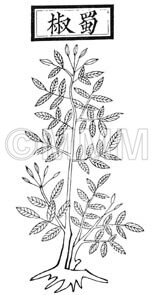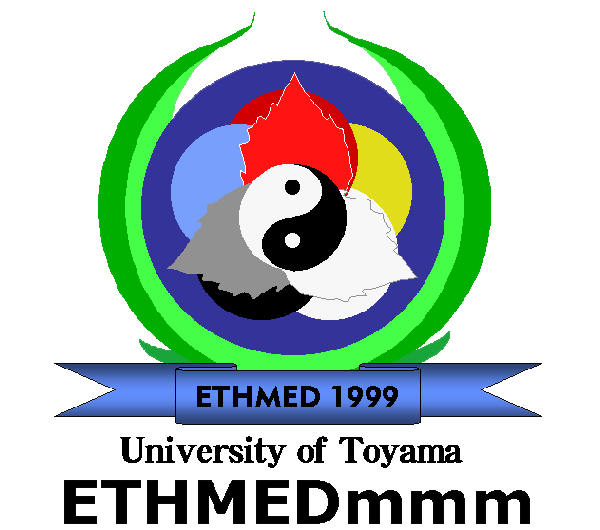Crude drug sample data base
※Click on the image to enlarge it.
Scientific information data base
| Common name | 花椒, Huajiao, Zanthoxyli Pericarpium (CP2020), (Non-JPS2022), Zanthoxylum Peel (CP2020), (Non-JPS2022) | |||||
|---|---|---|---|---|---|---|
| Synonyms | 川椒 | |||||
| crude drug image |
| |||||
| Original plant name | Zanthoxylum bungeanum Maximowicz, Zanthoxylum armatum De Candolle var. subtrifoliatum Kitamura1, Zanthoxylum schinifolium Siebold et Zuccarini (*B1), (Fuyuzanshō1) | |||||
| original plant image |
| |||||
| Family name | Rutaceae | |||||
| Used part | pericarp of mature fruit (w/o seeds) | |||||
| Quality for selection | Good one is fresh. It has a strong odor and sharp pungency. (TN) | |||||
| Official compendium | CP (2020 ed.), Non-JPS(2022) | |||||
| Clinical application | It is used as food in Japan. | |||||
| Medical system | Traditional Chinese medicine | |||||
| Drug effect in traditional medicine | Traditional classification | Drugs for dispelling internal cold | ||||
| Beneficial effect | [Property and Flavor] Warm; pungent. [Meridian Tropism] Spleen, stomach and kidney meridians. [Actions] To warm the middle energizer and relieve pain, kill worms to relieve itching. [Indications] Cold pain in the epigastrium and abdomen, vomiting and diarrhea, abdominal pain caused by worm accumulation; and for eczema, pudendal itching topically. | |||||
| Chemical constituent | Monoterpenoids Z. bungeanum (*C2): alpha-Pinene, Sabinene, Myrcene, Limonene, beta-Phellandrene, Ocimene, Linalool, Linalyl acetate Z. armatum var. subtrifoliatum (*C2): alpha-Pinene, Sabinene, Myrcene, Limonene, beta-Phellandrene, Ocimene, Linalool, beta-Caryophyllene, Xanthoxylin Phenylpropanoids Z. schinifolium (*C1): p-Methoxycinnamic aldehyde, Methylchavicol Coumarins Z. schinifolium (*C1): Bergapten Other aromatic derivatives Z. schinifolium (*C1): Anisaldehyde Other nitrogen compounds Z. bungeanum (*C2): gamma-Sanshool, Hydroxy-alpha-sanshool, Hydroxy-beta-sanshool, Hydroxy-gamma-sanshool Z. armatum var. subtrifoliatum (*C2): alpha-Sanshool, beta-Sanshool, gamma-Sanshool, Hydroxy-alpha-sanshool, Hydroxy-beta-sanshool, Hydroxy-gamma-sanshool | |||||
| Chemical structure |
※画像をクリックすると、拡大して表示されます。 | |||||
| Pharmacological effect | Stomachic property, antiflatulent, diuresis, vermifugal. | |||||
| DNA sequence | AF025505, AF026028 | |||||
| Classical reference (Chinese Herbal Classic "Zhenglei bencao") |  ※Click this image to see the actual image ※Click this image to see the actual image | |||||
| Disease | Abdominal pain, Intestinal parasite, Itching, Eczema, Gastroptosis, Dyspepsia, Vomiting, Chill, Muddy and watery stool, Lower back pain | |||||
| Formulation | Shobaito, Daikenchuto, Tokito, Kaikyushokushoto, Chukenchuto | |||||
| Related drugs | Japanese Zanthoxylum Peel, the pericarps of the ripe fruit of Zanthoxylum piperitum DC. | |||||
| References | Non-JPS2022: The Japanese standards for non-Pharmacopoeial crude drugs 2022. CP2020: Pharmacopoeia of the People's Republic of China 2020 edi. B1)Nat.Med.,49,137(1995); 50,328(1996); 51,194(1997). C1)The Encyclopedia of Wakan-Yaku with Color Pictures Vol. I, pp 205-207. C2)Nat.Med.,51,249(1997). | |||||
| Remarks | In China, Huajiao is used as Shujiao(蜀椒) in the formulation, while in Japan Sanshō is used. | |||||
| Last renewal date | 2022/11/11 | |||||











